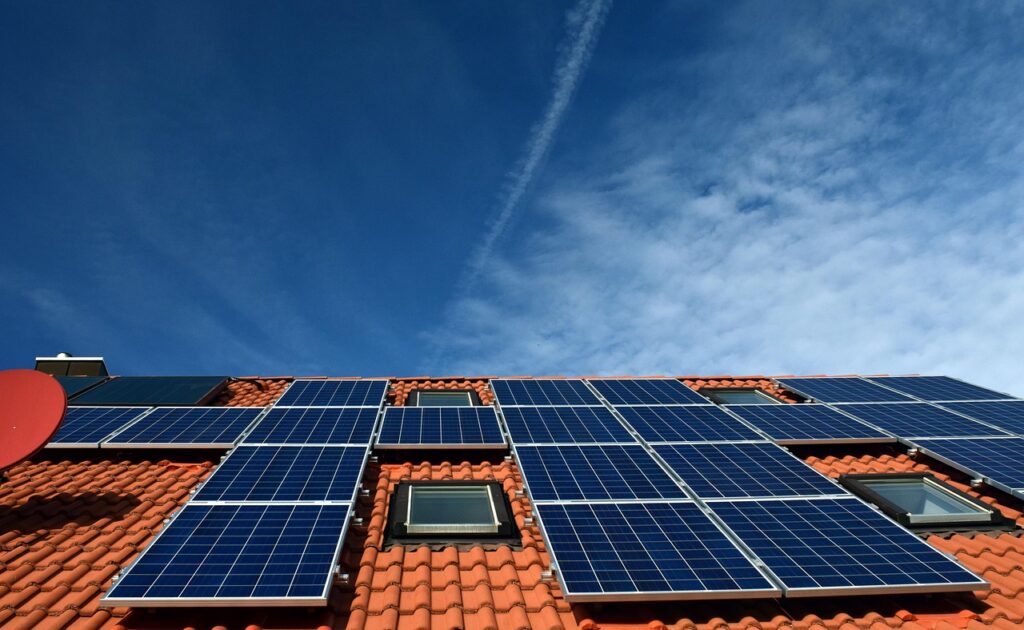Building-integrated photovoltaics (BIPV) are solar power systems designed to be an integral part of a building’s structure, such as roofs, windows, or facades. BIPV systems serve a dual purpose by functioning as both building materials and sources of electricity, seamlessly blending energy generation with architectural design.
This approach replaces conventional building materials with photovoltaic elements, reducing the need for separate solar panels while contributing to energy efficiency and sustainability. BIPV can lower overall costs and support the development of zero-energy buildings by converting sunlight directly into usable power without compromising the building’s aesthetics or function.
Core Concepts of Building Integrated Photovoltaics
Building Integrated Photovoltaics (BIPV) combine solar energy generation with the structural elements of a building. The technology integrates solar cells into building materials to create multifunctional components that replace traditional construction elements. This section covers the definition, various types of BIPV technologies, and key metrics related to their energy production and efficiency.
Definition and Overview
BIPV refers to photovoltaic systems that are seamlessly embedded within the building envelope, such as roofs, façades, or windows. Unlike traditional solar panels mounted on buildings, BIPV components replace customary materials, serving both as a building element and an energy generator. This dual functionality makes BIPV a more integrated and often aesthetically pleasing solution.
These systems must meet architectural requirements like weatherproofing and mechanical strength, while also converting sunlight into electricity. The integration can be in new construction or retrofitting projects. BIPV thereby supports sustainable building design by reducing reliance on external power sources and lowering building energy costs.
Types of BIPV Technologies
BIPV technologies vary primarily by their placement and material type. Common forms include:
- Roof-integrated modules: Photovoltaic tiles or panels replace traditional roof materials.
- Façade-integrated systems: Solar cells embedded within curtain walls, shading devices, or claddings.
- Window-integrated photovoltaics: Transparent or semi-transparent cells incorporated into glazing materials.
Materials can include crystalline silicon, thin-film, or emerging organic PV technologies. Each type balances factors like efficiency, translucency, cost, and ease of integration. The choice depends on building design, energy goals, and aesthetic preferences.
Energy Generation and Performance Metrics
The performance of BIPV systems is generally measured by:
- Energy output (kWh): Total electricity generated over time.
- Conversion efficiency (%): The ratio of converted sunlight energy to electrical energy.
- Power density (W/m²): Power generated per unit area of the BIPV surface.
External factors such as orientation, shading, and climate significantly affect these metrics. Additionally, system lifespan, degradation rate, and maintenance influence long-term performance. BIPV’s ability to generate renewable energy directly on-site helps reduce the building’s carbon footprint and reliance on grid electricity.
Design, Implementation, and Applications
Building-integrated photovoltaics (BIPV) combine solar energy generation with architectural elements, requiring careful design and implementation. Their varied applications range from façades to roofs, influencing both energy performance and building aesthetics. Successful integration depends on material selection, installation techniques, and addressing technical challenges for diverse settings.
Architectural Integration
BIPV systems are integrated into building envelopes, such as roofs, façades, and skylights, replacing conventional materials like glass or cladding. This requires collaboration between architects and engineers to ensure structural compatibility and visual harmony.
Design focuses on maximizing solar exposure while maintaining aesthetic appeal. For example, semi-transparent photovoltaic modules can be used in windows or curtain walls, balancing daylight and energy production.
Materials must meet building codes for insulation, fire resistance, and weatherproofing. The choice of module type—such as thin-film or crystalline silicon—affects both appearance and efficiency. Integration also considers shading, orientation, and angle to optimize energy yield.
Installation Methods and Best Practices
Installation of BIPV requires precise alignment with the building’s structural elements and electrical systems. Modules are often prefabricated and installed in place of traditional materials to minimize added weight.
Best practices emphasize weather tightness, robust electrical connections, and adequate ventilation behind the panels to avoid overheating. Integration with existing wiring and inverters must follow local electrical standards.
The process includes site assessment, load analysis, and coordination with other building systems. Maintenance access points must be planned to facilitate cleaning and repairs without compromising the building envelope.
Safety during installation is critical, especially on rooftops or high façades. Contractors often use standardized mounting kits tailored for different BIPV products to ensure secure attachment.
Applications in Residential and Commercial Buildings
In residential construction, BIPV is frequently used in sloped solar roofs and façade elements that blend seamlessly with home design. It helps homeowners reduce energy costs while maintaining curb appeal.
Commercial buildings leverage BIPV mainly on flat roofs and curtain walls, taking advantage of large surface areas for power generation. Office towers and retail centers use BIPV to meet sustainability certifications and reduce operational expenses.
Public buildings and institutions often deploy BIPV as part of green building strategies, integrating solar modules directly into windows or canopies. This use supports energy independence and demonstrates environmental commitments.
Industrial applications use BIPV selectively on warehouses and factories to offset energy use, often combined with energy storage systems for operational efficiency.
Challenges and Future Developments
BIPV faces challenges such as higher upfront costs compared to traditional cladding and standalone PV systems. The integration can complicate building design and require specialized installation skills.
Technical issues include maintaining electrical performance while ensuring durability and fire safety. Standardization of components and improved modular designs are crucial to overcoming these barriers.
Future developments focus on enhancing PV materials’ efficiency and flexibility. Innovations like building-integrated perovskite solar cells and multifunctional materials aim to increase energy yield and functionality.
Advancements in digital modeling tools also aid architects by simulating energy output and aesthetics early in the design phase, promoting wider adoption through optimized solutions.




